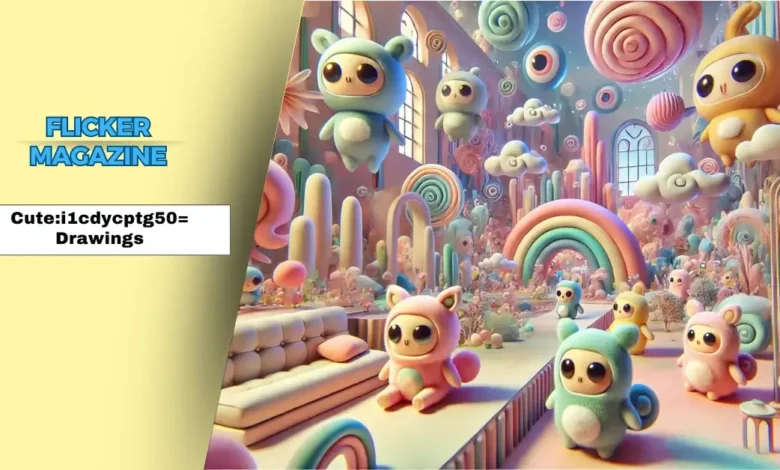cute:i1cdycptg50= drawings: A Journey into Adorable Artistry
When we think about art, we often wander to grand landscapes, intricate portraits, or abstract masterpieces. Yet, there’s an undeniable charm in the realm of cute:i1cdycptg50= drawings. Whether they’re doodles on a napkin, character sketches in a children’s book, or intricate designs in a digital format, cute drawings possess a unique ability to evoke joy and warmth. In this article, we’ll dive deep into the world of cute drawings, exploring their appeal, techniques, styles, and their impact on various communities.
The Allure of cute:i1cdycptg50= drawings
What Makes Drawings “cute:i1cdycptg50= drawings”?

The term “cute:i1cdycptg50= drawings” can be quite subjective, but certain elements universally contribute to the cuteness factor in drawings. Big eyes, rounded shapes, soft colors, and simplistic designs are often the hallmark traits of cute illustrations. These features tap into our innate affinity for youthful characteristics, creating an emotional connection with the viewer.
When artists intentionally exaggerate these features, they evoke a sense of innocence and playfulness. Think of beloved cartoon characters like Hello Kitty or Winnie the Pooh; their large, expressive eyes and simple forms make them instantly relatable and lovable. In essence, the cuteness of drawings often stems from their ability to resonate with our childhood memories, bringing forth a wave of nostalgia.
Cultural Variations in Cuteness
While the Western world may lean towards specific styles of cute:i1cdycptg50= drawings, many cultures have their interpretations of what constitutes “cute.” For instance, Japanese culture embraces the concept of “kawaii,” which translates to “cute” in English. Kawaii culture encompasses everything from fashion to food, and its influence on art is profound. Characters like Pikachu and Totoro embody the essence of kawaii, blending innocence with charm.
In contrast, cute Western drawings often focus on animals or whimsical characters. The art style may draw from nature, emphasizing fluffy animals, pastel colors, and fantasy elements. These cultural differences showcase the versatility of cute:i1cdycptg50= drawings, allowing them to resonate with diverse audiences while still holding a universal appeal.
Emotional Connection and Nostalgia
One of the most significant aspects of cute:i1cdycptg50= drawings is their ability to foster emotional connections. Art has always served as a means of communication, and cute drawings are no exception. They evoke feelings of happiness, comfort, and even nostalgia. For many, looking at a cute drawing can transport them back to simpler times, sparking memories of childhood adventures and innocent pleasures.
Moreover, cute:i1cdycptg50= drawings often serve as a form of escapism. In a world filled with stress and responsibilities, these delightful illustrations provide a momentary retreat into a whimsical realm where everything is soft and endearing. This emotional resonance makes cute drawings a powerful tool for artists, as they can convey complex feelings through seemingly simple imagery.
Techniques for Creating cute:i1cdycptg50= drawings
Essential Drawing Tools
Before diving into the creation of cute:i1cdycptg50= drawings, it’s essential to gather the right tools. Depending on your preferred medium, this can range from traditional supplies like pencils, pens, and watercolor paints to digital tools such as drawing tablets and software like Procreate or Adobe Illustrator.
For beginners, starting with simple materials like sketch pads and colored pencils can be incredibly rewarding. The tactile experience of drawing can enhance creativity, allowing artists to experiment without the constraints of digital tools. As you progress, incorporating markers or watercolor can add vibrancy to your drawings, further emphasizing the cute aesthetic.
Fundamental Drawing Techniques
Creating cute:i1cdycptg50= drawings involves understanding basic artistic techniques. Here are some fundamental skills that can elevate your artwork:
Shapes and Proportions: The foundation of cute:i1cdycptg50= drawings often lies in their shapes. Rounded forms typically convey softness and approachability. Start by sketching simple shapes and then build on them, adjusting proportions to enhance cuteness. For instance, oversized heads with smaller bodies can amplify the adorable factor.
Facial Expressions: Capturing emotions is crucial in cute:i1cdycptg50= drawings. Focus on the eyes, as they are often the most expressive feature. Large, sparkling eyes can convey innocence and wonder. Experiment with different expressions—happy, surprised, or mischievous—to bring your characters to life.
Color Palette: Color plays a significant role in the overall feel of a drawing. Soft pastels or bright, cheerful colors tend to amplify cuteness. When selecting a color palette, consider harmony and balance. Colors that complement each other can create a visually pleasing composition.
Digital vs. Traditional Art
In today’s digital age, artists have more options than ever when it comes to creating cute:i1cdycptg50= drawings. Traditional art allows for a personal touch, with textures and imperfections that can enhance the charm of a piece. On the other hand, digital art offers versatility and ease of editing, allowing for quick adjustments and experimentation.
Both mediums have their merits, and many artists blend the two. For example, starting with a traditional sketch and then scanning it to enhance it digitally can yield delightful results. The key is to find a medium that resonates with you and fits your artistic style.
Styles of cute:i1cdycptg50= drawings
Cartoonish Characters
Cartoonish characters are perhaps the most recognizable style in the realm ofcute:i1cdycptg50= drawings. These characters often feature exaggerated features, bright colors, and playful expressions. Popular examples include characters from animated series like “Adventure Time” or classic cartoons such as “Mickey Mouse.”
The appeal of cartoonish drawings lies in their simplicity and ability to convey emotions effectively. They are often designed to be relatable, allowing viewers to connect with the character’s personality and story. Creating your cartoon character involves playing with proportions, colors, and expressions, giving you the freedom to explore your creativity.
Animal Illustrations
Animals have long been a favorite subject for cute:i1cdycptg50= drawings. From cuddly puppies to fluffy kittens, animal illustrations evoke feelings of warmth and companionship. Many artists choose to anthropomorphize animals, giving them human traits and personalities. This approach can create an instant bond between the character and the viewer.
When drawing animals, focus on capturing their unique characteristics. For example, a chubby little bear with oversized ears can amplify cuteness, while a tiny bird with large eyes can evoke a sense of wonder. Experimenting with different animal species can also lead to discovering your unique style and flair.
Whimsical Landscapes
Cute drawings aren’t limited to characters; whimsical landscapes can also be incredibly charming. Think of fantasy worlds filled with oversized flowers, friendly creatures, and colorful skies. These illustrations often invite the viewer into a dreamlike realm, evoking a sense of adventure and exploration.
When creating a whimsical landscape, consider the use of perspective and depth. Playing with scale can enhance the enchanting quality of your artwork. Additionally, incorporating cute characters within the landscape can create a narrative, making the scene feel alive and inviting.
The Impact of Cute Drawings on Communities
Fostering Creativity in Kids
One of the most significant impacts of cute drawings is their ability to foster creativity in children. Many kids are drawn to these delightful illustrations, which can inspire them to explore their artistic talents. Coloring books filled with cute designs encourage children to engage in creative activities, helping them develop fine motor skills and artistic expression.
Furthermore, cute drawings often serve as storytelling tools. Characters like those in “Peppa Pig” or “My Little Pony” not only entertain but also teach valuable lessons about friendship, kindness, and adventure. This dual role enhances the educational value of cute art, making it a vital part of children’s development.
Building Online Communities
With the rise of social media, cute drawings have cultivated vibrant online communities. Platforms like Instagram, Pinterest, and TikTok showcase a plethora of artists sharing their cute creations. These communities foster collaboration and inspiration, allowing artists to connect, share techniques, and offer feedback.
The online presence of cute drawings also enables artists to gain recognition and establish a fan base. Many artists have turned their passion into profitable ventures, selling merchandise featuring their cute designs, from stickers to clothing. This shift has transformed cute drawings into a thriving industry, celebrating creativity in a digital age.
Therapeutic Benefits of Cute Art
Engaging with cute drawings can have therapeutic benefits for individuals of all ages. Art therapy often incorporates cute and whimsical elements to promote relaxation and emotional healing. The act of creating or simply observing cute art can induce feelings of happiness, reduce stress, and provide a sense of comfort.
For those struggling with mental health issues, cute drawings can serve as a coping mechanism. They provide a visual escape, allowing individuals to find solace in a world filled with positivity and light. This therapeutic aspect of cute drawings highlights their significance beyond mere aesthetics, establishing them as a valuable resource for emotional well-being.
How to Improve Your Cute Drawing Skills
Practice Regularly
Like any skill, improving your cute drawing abilities requires consistent practice. Set aside time each day or week to doodle, sketch, or experiment with new techniques. The more you draw, the more comfortable you’ll become with your style, and the better you’ll understand what makes your drawings cute.
Don’t be afraid to revisit old sketches and update them with new skills you’ve learned. This process not only shows your growth as an artist but also reinforces the idea that improvement is an ongoing journey.
Seek Inspiration
Inspiration can come from various sources, so keep your eyes open! Explore different art styles, whether it’s through books, social media, or nature. Visiting art galleries or attending local art events can also spark new ideas. Surrounding yourself with other artists and creative minds can fuel your imagination and push you to explore new avenues in your art.
Additionally, don’t hesitate to analyze your favorite cute drawings. Break down the elements that attract you to those pieces, whether it’s the color palette, character design, or overall composition. Understanding what resonates with you can guide your artistic journey.
Join Art Communities
Participating in art communities can be incredibly beneficial for your growth as an artist. Online platforms, local art groups, or social media can connect you with fellow artists who share your passion for cute drawings. These communities often offer constructive feedback, tips, and support that can motivate you to improve.



